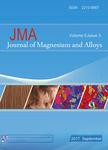Effect of multifunction cavitation using phosphoric acid on fatigue and surface properties of AZ31 magnesium alloy
作者机构:Graduate School of Integrated Science and TechnologyShizuoka University3-5-1 JohokuNaka-kuHamamatsuShizuoka432-8561Japan Department of Mechanical EngineeringSanyo-Onoda City University1-1-1 Daigaku-DoriSanyo-OnodaYamaguchi 756-0884Japan Tokyo Metropolitan University1-1 Minami-OsawaHachiojiTokyo 192-0397Japan Department of Mechanical EngineeringFaculty of EngineeringShizuoka University3-5-1 JohokuNaka-kuHamamatsu-shiShizuoka 432-8561Japan
出 版 物:《Journal of Magnesium and Alloys》 (镁合金学报(英文))
年 卷 期:2023年第11卷第6期
页 面:1996-2005页
核心收录:
学科分类:08[工学] 080502[工学-材料学] 0805[工学-材料科学与工程(可授工学、理学学位)]
基 金:Grants-in-Aid for Scientific Research [21K14059] Funding Source: KAKEN
主 题:Magnesium alloy Multifunction cavitation Surface modification Fatigue Residual stress
摘 要:Magnesium alloy is attractive for lightweight construction but often suffers from poor corrosion resistance and low *** processing with chemicals,i.e.,multifunction cavitation(MFC),was introduced to form a high-corrosion film and improve the fatigue properties of an AZ31 magnesium *** analysis and plane bending fatigue tests were conducted for the MFC-treated magnesium alloy at a stress ratio,R,*** mechanical action of cavitation bubbles improved the fatigue life of magnesium alloys due to increasing the surface hardness and generating compressive residual ***,the combined mechanical and electrochemical action during MFC formed pits on the *** pits were large enough to easily nucleate an initial fatigue *** addition,the magnesium alloys without pit formation,for which a coating process using phosphoric acid was conducted after MFC using water,showed superior fatigue properties.




